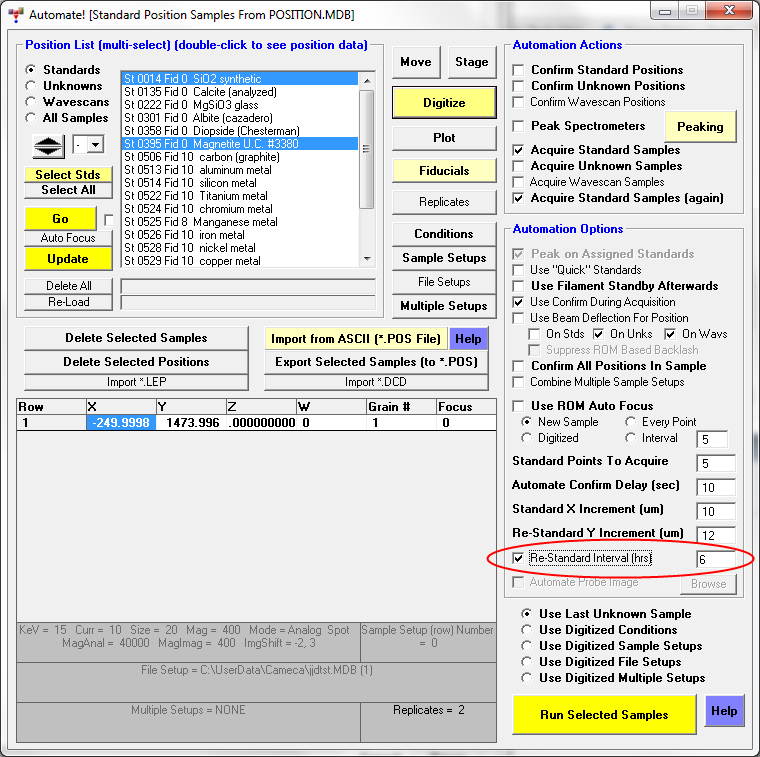I am inquiring about beam regulation (stability) on a Cameca SX100 using PfE software when using Combined Conditions.
The project involves analyzing steel for 5 minor/trace elements and 2 major elements. The Combined Conditions involve switching from 200 nA – 1 micron beam – 80 s on peak, to 20 nA – 1 micron beam – 30 s on peak.
The PfE Analysis Calculation Options are:
- Beam Drift Correction ON
- Automatic Drift Correction ON
PfE is setting the conditions for each point.
The run involves hundreds of points, so a lot of work for the beam regulator.
As the run progresses, I am seeing an increasing number of high totals (105 to 115 wt%), which I presently attribute to mis-reading of the current.
The instrument was serviced last week (cleaned the lower graphite tube, cleaned Faraday cup, installed new beam regulator).
Thus, the instrument is (was) in good shape.
Is there something that I should be doing differently in the PfE software, or should I expect that the hardware simply require more servicing?
Hi Andrew,
Excellent questions. First let me start by saying that using combined conditions itself should not cause any beam drift issues. Yes, it does work the beam current regulator a lot more than a single condition does, but if the beam current regulator is clean and working, it should just cycle between the conditions. You mentioned using 200 nA and 20 nA, I assume 20 nA for the majors (run first correct?), then 200 nA for the traces?
We do a lot of combined condition acquisitions on melt inclusions (usually 10 or 20 nA on the majors with the TDI correction turned on and 50 to 100 nA for S, Cl, P, F, etc.) and we see no beam drift problems on our Sx100. That said, it would be helpful if you could post some data since PFE acquires a beam current both before and after each analysis. For combined condition samples it looks like this:
Faraday or Beam Currents:
ELEM: na ka si ka k ka al ka mg ka ca ka s ka fe ka cl ka ti ka p ka f ka
71G 10.010 10.010 10.010 10.010 10.010 10.010 50.020 10.010 50.020 50.020 50.020 50.020
72B 10.002 10.002 10.002 10.002 10.002 10.002 49.973 10.002 49.973 49.973 49.973 49.973
73B 9.985 9.985 9.985 9.985 9.985 9.985 49.994 9.985 49.994 49.994 49.994 49.994
74B 10.007 10.007 10.007 10.007 10.007 10.007 49.992 10.007 49.992 49.992 49.992 49.992
75B 9.994 9.994 9.994 9.994 9.994 9.994 50.023 9.994 50.023 50.023 50.023 50.023
AVER: 10.010 10.010 10.010 10.010 10.010 10.010 50.020 10.010 50.020 50.020 50.020 50.020
SDEV: .000 .000 .000 .000 .000 .000 .000 .000 .000 .000 .000 .000
Second Faraday or Beam Currents:
ELEM: na ka si ka k ka al ka mg ka ca ka s ka fe ka cl ka ti ka p ka f ka
71G 9.998 9.998 9.998 9.998 9.998 9.998 49.970 9.998 49.970 49.970 49.970 49.970
72B 9.994 9.994 9.994 9.994 9.994 9.994 50.028 9.994 50.028 50.028 50.028 50.028
73B 10.003 10.003 10.003 10.003 10.003 10.003 49.997 10.003 49.997 49.997 49.997 49.997
74B 10.000 10.000 10.000 10.000 10.000 10.000 49.984 10.000 49.984 49.984 49.984 49.984
75B 10.015 10.015 10.015 10.015 10.015 10.015 50.029 10.015 50.029 50.029 50.029 50.029
AVER: 9.998 9.998 9.998 9.998 9.998 9.998 49.970 9.998 49.970 49.970 49.970 49.970
SDEV: .000 .000 .000 .000 .000 .000 .000 .000 .000 .000 .000 .000
In this example, the majors were acquired at 10 nA and the traces at 50 nA. Note that PFE utilizes the average of the two beam currents for the beam drift correction (if both are present) for performing the beam drift correction. However, if the nominal beam is set to zero, there will be no drift correction applied to the x-ray intensities. This is the same as unchecking the Use Beam Drift Correction in the Analytical | Analysis Option menu dialog. The software should warn you if this is the case.
Perhaps you could post an example of the beam currents you are seeing as I did above. For example: is the beam current drift you are seeing occurring within a single analysis point? Or is the drift occurring over time, say overnight? The latter brings up temperature control concerns in the lab.
Now, next is the standard drift correction you mentioned, which works in conjunction with the beam drift correction, and which is applied to each analysis point. If the standard drift correction is turned on in the Analytical | Analysis Options menu dialog, the software will automatically correct *each element* unknown intensity for any changes over time based on the most recent standardization acquired previously and subsequently to the data point being analyzed. That is assuming you have more than one standardization in a run. This means that you should acquire a standard set at the beginning of your run and also at the end of your run. The Automate! window provides an option for this is the Automation Actions group of controls as seen here:

You can also set the software to automatically acquire a standard set every n hours as seen here:

Here is an example from my lab with a number of standardization automatically acquired during a long run:
http://probesoftware.com/smf/index.php?topic=332.msg1741#msg1741The manual discusses the standard drift correction here:
http://probesoftware.com/download/PROBEWIN.pdf#page=334My first take on your beam drift issue is that your instrument should not be experiencing drift of 5 to 15% in the beam current over time, but how much does temperature vary in your lab over a 24 hours period? I know I'm bragging here but here is some monitoring of our lab temperature (see attached below).
john